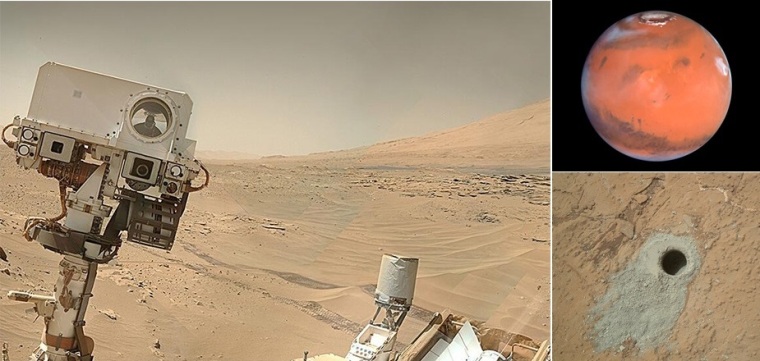In Major Find, NASA Discovers Signs Of Possible Life On Mars

The "oh my gosh" moment in the exploration of Mars has come: Scientists have announced not one, but two pieces of evidence that strongly suggest that the Red planet could be harboring life.
On Tuesday, NASA announced that its Mars rover Curiosity has found carbon-containing compounds in samples drilled out of an ancient rock. It marked the first time organic compounds – the building blocks for life – have been detected on the surface of Mars.
Moreover, the rover also found spurts of methane gas in the Martian atmosphere. Methane is a chemical produced either by living things or by geochemical processes.
"We have had a major discovery. We have found organics on Mars," Curiosity lead scientist John Grotzinger, with the California Institute of Technology in Pasadena, Calif., announced during a webcast press conference at the American Geophysical Union conference in San Francisco.
"The probability of any of these things being sources (from life) ... we just have to respect that it is a possibility," he added.
The latest findings marked a major turning point in the exploration of Mars. Just a year ago, NASA's Curiosity rover reported that after eight months of searching it had not found evidence of methane gas on Mars, all but dashing hopes that organisms might be living there now.
Despite its negative findings, the Curiosity rover continued to take samples of the Martian air. Finally in November 2013, according to NASA, the rover suddenly detected the presence of a large amount of methane around it which lasted for 60 days before vanishing.
The methane detections by Curiosity appeared to confirm observations by Earth-based telescopes and Mars-orbiting spacecraft that found mysterious but fleeting plumes of methane on the surface of the planet.
Scientists said the presence of methane is significant because the gas cannot exist for long in the harsh Martian atmosphere, which means that the detected methane must have been created just recently.
They said the methane could have been produced by geological process or could be a product of life in the form of microbes which release methane as a waste product.
Even if it turns out that methane's origin is geological, it would still suggest that the gas is coming from hydrothermal systems that could be prime locations to search for signs of life, the scientists said.
As for the organic molecules found by Curiosity, they showed up in a mudstone nicknamed Cumberland which the rover drilled in May 2013.
According to NASA scientists, Curiosity's miniature chemistry laboratory detected significant amounts of the organic molecule chlorobenzene, which is not a naturally occurring compound on Earth.
"In part, Curiosity was built to explore for organics," Dr. Grotzinger said, "and we found them."
The organics in Mars could have been delivered by comets and asteroids crashing onto the surface or produced indigenously, scientists said. Wherever they came from, they face a tough life on Mars which is constantly bombarded by deadly cosmic rays, they added.
Last week, scientists disclosed that the crater where Curiosity now sits was once filled with water, with sediments building up over time to form a 5-km high mountain called Mount Sharp.
Right after it landed, Curiosity found that the planet most like Earth in the solar system had the right chemical ingredients and environmental conditions to support microbial life, fulfilling the primary goal of the mission.
 Christians don't have to affirm transgenderism, but they can’t express that view at work: tribunal
Christians don't have to affirm transgenderism, but they can’t express that view at work: tribunal Archaeology discovery: Medieval Christian prayer beads found on Holy Island
Archaeology discovery: Medieval Christian prayer beads found on Holy Island Presbyterian Church in America votes to leave National Association of Evangelicals
Presbyterian Church in America votes to leave National Association of Evangelicals Over 50 killed in 'vile and satanic' attack at Nigerian church on Pentecost Sunday
Over 50 killed in 'vile and satanic' attack at Nigerian church on Pentecost Sunday Ukrainian Orthodox Church severs ties with Moscow over Patriarch Kirill's support for Putin's war
Ukrainian Orthodox Church severs ties with Moscow over Patriarch Kirill's support for Putin's war Islamic State kills 20 Nigerian Christians as revenge for US airstrike
Islamic State kills 20 Nigerian Christians as revenge for US airstrike Man who served 33 years in prison for murder leads inmates to Christ
Man who served 33 years in prison for murder leads inmates to Christ


 Nigerian student beaten to death, body burned over ‘blasphemous’ WhatsApp message
Nigerian student beaten to death, body burned over ‘blasphemous’ WhatsApp message 'A new low': World reacts after Hong Kong arrests 90-year-old Cardinal Joseph Zen
'A new low': World reacts after Hong Kong arrests 90-year-old Cardinal Joseph Zen Iran sentences Christian man to 10 years in prison for hosting house church worship gathering
Iran sentences Christian man to 10 years in prison for hosting house church worship gathering French Guyana: Pastor shot dead, church set on fire after meeting delegation of Evangelicals
French Guyana: Pastor shot dead, church set on fire after meeting delegation of Evangelicals ‘Talking Jesus’ report finds only 6% of UK adults identify as practicing Christians
‘Talking Jesus’ report finds only 6% of UK adults identify as practicing Christians Mission Eurasia ministry center blown up in Ukraine, hundreds of Bibles destroyed: 'God will provide'
Mission Eurasia ministry center blown up in Ukraine, hundreds of Bibles destroyed: 'God will provide' Church holds service for first time after ISIS desecrated it 8 years ago
Church holds service for first time after ISIS desecrated it 8 years ago Burger King apologizes for 'offensive campaign' using Jesus' words at the Last Supper
Burger King apologizes for 'offensive campaign' using Jesus' words at the Last Supper Uganda: Muslims abduct teacher, burn him inside mosque for praying in Christ’s name
Uganda: Muslims abduct teacher, burn him inside mosque for praying in Christ’s name